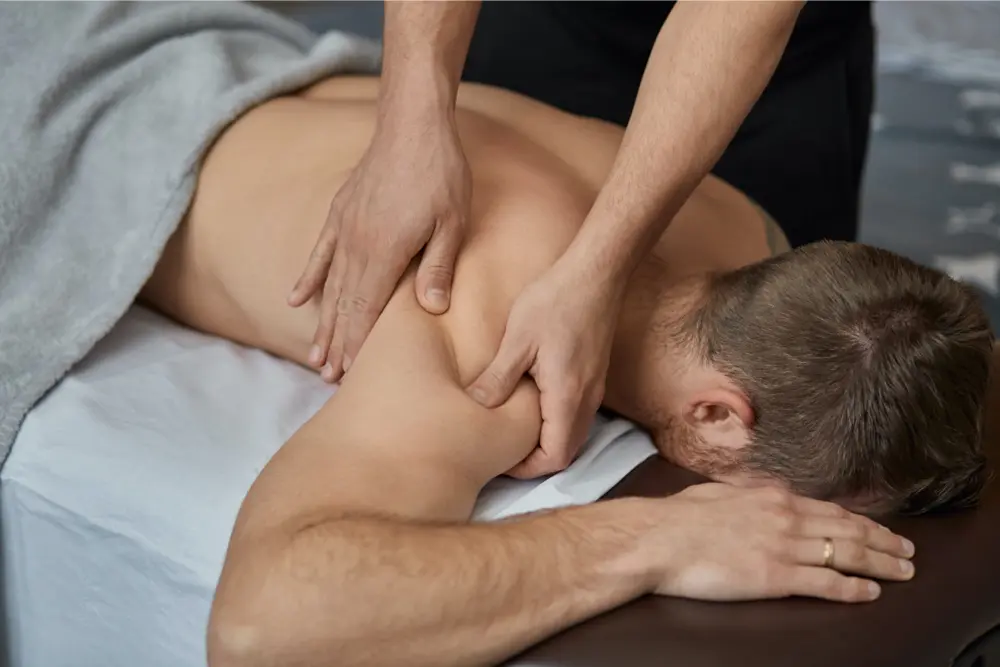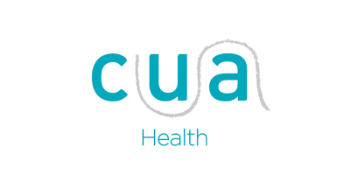Deep Tissue Massage Brisbane – Knead Massage is here to help!
What’s deep tissue massage?
Looking for deep tissue massage in Brisbane? Deep tissue massage is a technique that qualified Remedial Massage Therapists, Sports Massage Therapists and Myotherapists use to reduce muscle pain from overworked, unhappy muscles. This massage technique focuses on the lower layers of muscle tissue, using slow, firm pressure to target specific areas of tension and pain. Trigger point therapy, myofascial release, and other techniques are also used to help alleviate muscle injuries, chronic pain, and restricted joint mobility. We offer the best deep tissue massage in Brisbane to help you feel better and get back to doing what you love.
Book your Deep Tissue Massage Now
Why get deep tissue massage?
As the name suggests, Deep Tissue Massage focuses on the deep tissue layers of muscle tissue, receptor organs, tendons, and fascia. It can be an extremely effective intervention, both relaxing and relieving. Expert deep tissue massage from a qualified therapist can quickly interrupt the pain cycle that is happening between the brain and the muscle. This triggers the brain to release “happy” neurochemicals and cause the stressed muscle to relax. Excellent for those suffering from pinched nerves, sciatica, stiff joints, and other conditions. Brisbane deep tissue massage experts Knead Massage can assist with recovery from injury, sports prep, muscle tension and knots, making deep tissue massage a valuable addition to your wellness routine.
How deep tissue massage helps?
There are several benefits to deep tissue massage, including:
Pain relief – deep tissue techniques target specific areas of pain, using deep pressure to relieve tension and stiffness.
Improved posture: Deep tissue massage can help to correct postural imbalances and improve overall body alignment. This can lead to reduced stress on the joints and improved mobility, making it easier to perform daily activities.
Reduced stress and anxiety: Massage has been shown to reduce cortisol levels, the primary neurochemical driver of stress. Massage may promote relaxation and sleep.
Enhanced athletic performance: Athletes often benefit from deep tissue work – as there are improvements to circulation, reductions in muscle soreness, and an increase in joint range of motion.
Book your Deep Tissue Now
When to get deep tissue massage?
An expert deep tissue massage is useful when you are suffering with muscle spasm, restricted movement, muscle tension, chronic muscle pain, postural pain (office work or bending the neck or back a lot), or when you are recovering from an injury.
Deep tissue massage is especially useful for chronically overworked areas of the body such as the neck and shoulders, low back or legs.
Conditions that may respond well to deep tissue massage include:
- Tension headache, Cervicogenic Headache and Migraine
- Crick neck, Wry neck, Neck stiffness
- Low Back Pain, Sciatica
- Calf Strain, Calf Tear
- Runners Knee, Jumpers Knee, patellar tendinopathy
- Plantar fasciitis
Restore balance with Deep Tissue Massage
How deep tissue massage is done?
- A professional therapist will:
- discuss your areas of concern and determine what is bothering you.
- Find out what your massage preferences are.
- Assess the affected areas and determine which techniques are suitable for you and your condition.
Deep massage is designed to target specific areas of the body that are tight, sore, or in pain. Your therapist will use hands, fingers, and sometimes elbows to apply pressure and manipulate the muscles. The deep pressure helps relieve tension and increase flexibility. Deep massage is useful for individuals who suffer from chronic pain, muscle stiffness, or soreness.
Can deep tissue massage cause damage?
Unqualified deep tissue massage has significant risk factors.
The risk of injury from a qualified Remedial Massage Therapist or Myotherapist (someone who has a Diploma, Advanced Diploma or Bachelor of Health Science) are very low.
These therapists are:
- experts at providing deep tissue massage
- are insured for their professional actions
- are trained to understand what conditions (and individuals) will respond well to Deep Tissue Massage
- and have enough education to know when they should not use deep tissue techniques.
Shopping centre therapists have very diverse qualification levels and experience – caution should be used before receiving deep tissue treatment from them.
Book your Deep Tissue Massage Now
How long to heal from deep tissue massage?
Recovery from a deep tissue massage depends on your pressure preference. It’s generally advised to have 24 – 48 hours without physical strain to the areas worked. As such lifting weights or running in the first day or two after receiving your treatment are discouraged. If you load the tissue that has had deep tissue work in this time it will potentially cause muscle spasm and tightening up – undoing the benefits of the treatment.
Commonly hot water and magnesium powder (Epsom salts) are used to help the muscle relax and improve the blood supply to the tissue, which may be aggravated from treatment.
How often should I get this type of treatment?
Deept tissue massage brisbane – The frequency that you get massage is dependent on the physical strain you are under, the type of work you do and what kind of self care you practice. Some office workers have significant neck, shoulder and arm pain and require treatment monthly or more. The standard of the therapist you see is also a factor in the frequency of treatment – an expert remedial massage therapist or Myotherapist may see you two or three times in a few weeks to unwind your stress and pain, and then not for many months. If you have a very repetititve job, are under heavy stess you may choose to have a maitenance treatment every 4 – 8 weeks. This helps relieve tension, improve muscle health and stops you from getting back into acute pain.
Book your Deep Tissue Massage Now
How much does treatment cost?
The complete price list for Knead Massage Brisbane is here:
https://www.kneadworkmassage.com/massage-brisbane-pricing/
At Knead Massage we have two price points (levels of qualification) with our therapists – Regular Therapists and Senior-Advanced Therapists.
Book your Deep Tissue Massage Now
FAQs
Are deep tissue massage good for you?
There are several benefits to deep tissue massage, including:
Pain relief – deep tissue techniques target specific areas of pain, using deep pressure to relieve tension and stiffness.
Improved posture: Deep tissue massage can help to correct postural imbalances and improve overall body alignment. This can lead to reduced stress on the joints and improved mobility, making it easier to perform daily activities.
Reduced stress and anxiety: Massage has been shown to reduce cortisol levels, the primary neurochemical driver of stress. Massage may promote relaxation and sleep.
Enhanced athletic performance: Athletes often benefit from deep tissue work – as there are improvements to circulation, reductions in muscle soreness, and an increase in joint range of motion.
Are deep tissue massages painful?
Can deep tissue massage cause blood clots?
This is highly unlikely from a trained individual. However, if you are on blood thinners or suffer from a clotting disorder it is possible. Receiving massage treatments from under/unqualified individuals greatly increases the risks associated with deep tissue work.
Can deep tissue massage cause bruising?
Can deep tissue massage cause damage?
The risk of injury from a qualified Remedial Massage Therapist or Myotherapist (someone who has a Diploma, Advanced Diploma or Bachelor of Health Science) are very low.
These therapists are:
- experts at providing deep tissue massage
- are insured for their professional actions
- are trained to understand what conditions (and individuals) will respond well to Deep Tissue Massage
- and have enough education to know when they should not use deep tissue techniques.
Shopping centre therapists have very diverse qualification levels and experience – caution should be used before receiving deep tissue treatment from them.
Can deep tissue massage cause nausea?
The evidence is unclear, however anecdotal evidence suggests that some individuals may feel “off colour” after deep tissue treatment. The mechanisms are alleged to be the release of chemical by-products into the blood. Recent science suggests that this is not plausible.
Can deep tissue massage cause pain?
By their nature deep tissue massages are likely to cause discomfort – as you are applying deep physical pressure to an irritable or tight structure. In order for the brain to release the chemicals that cause the tight tissue to relax, the tissue has to feel discomfort or even some pain. An expert remedial massage therapist is able to communicate with you and observe you to understand what you find tolerable or even relieving.
Can deep tissue massage cause sciatica?
It is unlikely that receiving deep tissue massage from a qualified remedial massage therapist would cause sciatica. Theoretically an untrained individual or undertrained individual may apply too much pressure in the lower back or hip area and could cause muscle spasm that might compress the sciatic nerve, leading to sciatic pain. Additionally, if the person receiving the massage already has sciatica or a related condition – untrained massage could worsen their symptoms.
Can deep tissue massage cause weight gain?
No – this claim has no basis in fact. The only conceivable explanation for weight gain from massage is if you stress eat because of it
Can deep tissue massage help plantar fasciitis?
- Expert plantar fasciitis massage can immediately reduce plantar fasciitis pain by reducing muscular tension in the calves which are causing tension in the plantar fascia tendon.
- Rubbing the plantar fascia itself is of limited value, however releasing the muscle tension in the lower leg will usually have an immediate impact on pain reduction.
- A remedial massage therapist can show you how to keep your calves from becoming tight again after your plantar fasciitis massage.
Deep tissue massage and cupping?
Combining the temporary relaxation response that can occur in tissue from cups with deep tissue massage can be an effective way to reduce pain from muscle tension. In evidence based practice, cupping is used to temporarily reduce tone in overactive, painful muscle tissue. The stretch caused by the cup suction stimulates small diameter nerve endings in the skin and muscles, which trigger impulses to the spinal cord – causing the release of pain modulating neurotransmitters (endorphins and monoamines) which block the pain messages and temporarily reduce muscle tone. An evidence based clinician that uses cups will not use them as a stand alone treatment. An evidence based clinician that uses cups will not apply the cups to one location for much longer than 5 minutes.
Deep tissue massage and fibromyalgia?
It is not advisable for people suffering fibromyalgia to receive tru deep tissue massage. Fibromyalgia is a condition where the body does not shut off inflammation, and deep tissue massage, like exercise is a temporarily inflammatory process.
Deep tissue massage and pregnancy?
A qualified remedial massage therapist is trained to deliver massage interventions to pregnant people. As with all conditions there are safety concerns and absolute areas to avoid – the stomach. Most qualified remedial massage therapists will work on pregnant people in a sidelying pose to avoid compressing the foetus and also to minimise the weight of the baby on the mothers inferior vena cava.
Deep tissue massage and sports massage?
In the abstract these two types of massage are different, but in practice the “methods” are used interchangeably. A true sports massage is designed to either warm up tissue and improve blood flow before an athletic event or afterwards to determine injury and tension. Deep tissue massage is by its nature going to cause inflammation and muscle soreness, so it is unlikely that immediately pre or post event you will be getting true deep tissue massage. Usually deep tissue massage is best done 5-7 days before the event and 3-5 days after.
Deep tissue massage for back pain?
These types of symptoms often respond well to Remedial Massage. Remedial Massage or deep tissue massage is especially in the early “acute” stages.
- Stiff hips – when people forward ben without enough hip movement, they must bend through the back. The spine is designed to share this load with the hips, which are the midpoint hinge of our skeleton.
- repetitive movements
- New activities in the habitually sedentary
- postural considerations (such as daily sitting)
- unstable spinal segments (often attributed to weak core strength – many causes including high body mass, pregnancy, sedentary lifestyle, recovery from injury)
- Unstable spinal segments caused by stretched spinal ligaments (most commonly associated with pregnancy)
- Overloading (lifting beyond capacity)
- Spending greater than 2 hours per day in a vehicle (vibration and excessive sitting without muscular activation to absorb force)
- Extreme leg length discrepancy (approx. 5cm difference)
- Age related change to vertebral joints, pelvis and the hips (arthritic change, modic change [oedema in the bone] and spinal stenosis)
Mechanical pain can often be reduced by finding the offending posture or movement and strengthening the muscles that reverse it. Improving movement patterns such as sit to stand, the squat or deadlift can also radically improve low back pain by reducing the constant irritation to the angry structure through a “correction”.
Deep tissue massage for plantar fasciitis?
- Expert plantar fasciitis massage can immediately reduce plantar fasciitis pain by reducing muscular tension in the calves which are causing tension in the plantar fascia tendon.
- Rubbing the plantar fascia itself is of limited value, however releasing the muscle tension in the lower leg will usually have an immediate impact on pain reduction.
- A remedial massage therapist can show you how to keep your calves from becoming tight again after your plantar fasciitis massage.
- Performing simple modified calf raises has been PROVEN to change the pain generating chemical makeup in the reactive tendon. Without going into biochemistry too deeply, these exercises help make the collagen of the tendon more stable and able to withstand load – while immediately reducing pain
The sooner you act on heel pain caused by plantar fasciitis, the easier it is to resolve. The first person you should see is a Remedial Massage Therapist for Expert Plantar Fasciitis Massage. Changing the muscle tension in the lower leg, learning the best stretches to keep the lower leg muscles loose, finding the best exercise to improve the angry reactive tendon causing the pain and learning about a heel pad will make a long painful journey much, much shorter.
Deep tissue massage for sciatica?
A qualified Remedial Massage Therapist performing Deep tissue massage can be extremely useful to reduce the nerve symptoms of sciatica travelling throught the buttock and down the leg. One type of sciatica – piriformis syndrome, is especially receptive to Deep Tissue Massage. Releasing tight low back muscles and calf muscles and hamstrings can be very powerful ways to reduce the sensations of Sciatica.
Deep tissue massage with cupping?
At Knead Massage we practice according to evidence based principles. Cupping is not a stand-alone treatment and when the technique is used, it is ALWAYS used to allow your therapist to work on more than one area simultaneously (usually for a few minutes before serious deep tissue work starts on the area). We feel cups are best used to prepare an area for longer lasting benefits derived from massage techniques.
Deep tissue massage with doms?
Deep Tissue Massage can improve the blood flow to muscles affected by DOMS. However sports massage techniques, which are lighter and more about circulation are probably tolerated better, as getting deep muscle work into tissue that is suffering from DOMS is very painful.
Deep tissue massage with elbow?
A qualified remedial massage therapist is trained to use their elbow to deliver light, medium and heavy pressure. An experienced massage therapist is adept at sensing tissue density using the elbow. However, most therapists would use their forearms most of the time as the broader contact surface is far less painful and equally effective at reducing muscle tone.
Deep tissue massage with hot stones?
Combining hot stones with deep tissue massage techniques is an excellent way to relax a muscle and then work deeply on the same tissue. The heat from the stones improves blood flow and induces a relaxation response through multiple physiological processes, this relaxed state (parasympathetic response) enables the qualified remedial massage therapist to work more deeply with fewer obstacles to your happiness.
Deep tissue massage with metal?
These techniques are called instrument assisted soft tissue mobilisation (IATSM). The skill set required to perform IATSM work is high and we personally would not advise getting these types of treatments from anyone without a degree in a health field. Clinical Myotherapist Liza Markova is certified to use IATSM and also holds a B.HSc in Clinical Myotherapy. Do not let untrained individuals in shopping centres perform these techniques on you – if someone has a degree in acupuncture, they are insurable for these techniques.
Deep tissue massage with oil?
Deep tissue massage with oil or balm is the most common way to receive deep tissue massage. Massage is usually a skin on skin intervention and requires a certain amount of exposed skin to truly be effective and long lasting. A qualified remedial massage therapist is trained to deliver massage interventions using oil, balm and through sheets or towels.
Deep tissue massage with tools?
Some Remedial Massage Therapists may use plastic or wooden tools to “Triggerpoint” a taut band in the muscle. A qualified therapist is trained to deliver this type of treatment and will work in a sensitive fashion, ensuring that you are receiving a pressure that is within your tolerance spectrum.
Using metal implements are called instrument assisted soft tissue mobilisation (IATSM). The skill set required to perform IATSM work is high and we personally would not advise getting these types of treatments from anyone without a degree in a health field. Clinical Myotherapist Liza Markova is certified to use IATSM and also holds a B.HSc in Clinical Myotherapy. Do not let untrained individuals in shopping centres perform these techniques on you – if someone has a degree in acupuncture, they are insurable for these techniques.
Deep tissue vs full body massage?
These terms are fairly non-specific. A full body massage implies that there is a relaxation element and that the person receiving the treatment has few specific musculoskeletal terms. Deep tissue massage imples that there are areas that require deep therapeutic pressure and less of a relaxation experience is needed.
Does deep tissue massage hurt?
By their nature deep tissue massages are likely to cause discomfort – as you are applying deep physical pressure to an irritable or tight structure. In order for the brain to release the chemicals that cause the tight tissue to relax, the tissue has to feel discomfort or even some pain. An expert remedial massage therapist is able to communicate with you and observe you to understand what you find tolerable or even relieving.
How deep tissue massage helps?
Deep Tissue Massage focuses on the deep tissue layers of muscle tissue, receptor organs, tendons, and fascia – it can be an extremely effective intervention. Expert deep tissue massage from a qualified therapist can quickly interrupt the pain cycle that is happening between the brain and the muscle – convincing the brain to release “happy” neurochemicals and cause the stressed muscle to relax.
There are several benefits to deep tissue massage, including:
Pain relief – deep tissue techniques target specific areas of pain, using deep pressure to relieve tension and stiffness.
Improved posture: Deep tissue massage can help to correct postural imbalances and improve overall body alignment. This can lead to reduced stress on the joints and improved mobility, making it easier to perform daily activities.
Reduced stress and anxiety: Massage has been shown to reduce cortisol levels, the primary neurochemical driver of stress. Massage may promote relaxation and sleep.
Enhanced athletic performance: Athletes often benefit from deep tissue work – as there are improvements to circulation, reductions in muscle soreness, and an increase in joint range of motion.
How deep tissue massage is done?
A professional therapist will:
- discuss your areas of concern and determine what is bothering you.
- Find out what your massage preferences are.
- Assess the affected areas and determine which techniques are suitable for you and your condition.
Deep massage is designed to target specific areas of the body that are tight, sore, or in pain. Your therapist will use hands, fingers, and sometimes elbows to apply pressure and manipulate the muscles. The deep pressure helps relieve tension and increase flexibility. Deep massage is useful for individuals who suffer from chronic pain, muscle stiffness, or soreness.
How deep tissue massage works?
Deep Tissue Massage focuses on the deep tissue layers of muscle tissue, receptor organs, tendons, and fascia – it can be an extremely effective intervention. Expert deep tissue massage from a qualified therapist can quickly interrupt the pain cycle that is happening between the brain and the muscle – convincing the brain to release “happy” neurochemicals and cause the stressed muscle to relax. This is beneficial for those suffering from pinched nerves, sciatica, stiff joints, and other conditions. Brisbane deep tissue massage experts Knead Massage may aid with movement ease and assist with recovery from injury, making it a valuable addition to your wellness routine.
How does deep tissue massage release toxins?
The post massage toxin release theory is not supported by science. The theory posits that chemical by products are released from the muscle after the hydraulic movement of blood through the tissue and the lymphatic system being stirred up by the pressure. Lymphatic drainage massage is only 1% of the pressure of deep tissue massage – any more pressure than this and the lymph vessels are being compressed and not effectively moving lymph fluid. It is more likely that the feeling of fatigue that is experienced after deep tissue massage is a result of the bodies own pain control system which releases opioids (and other “happy” neurochemicals) to reduce the discomfort associated with deep tissue massage.
How does deep tissue massage release toxins?
The post massage toxin release theory is not supported by science. The theory posits that chemical by products are released from the muscle after the hydraulic movement of blood through the tissue and the lymphatic system being stirred up by the pressure. Lymphatic drainage massage is only 1% of the pressure of deep tissue massage – any more pressure than this and the lymph vessels are being compressed and not effectively moving lymph fluid. It is more likely that the feeling of fatigue that is experienced after deep tissue massage is a result of the bodies own pain control system which releases opioids (and other “happy” neurochemicals) to reduce the discomfort associated with deep tissue massage.
How long does a deep tissue massage take to heal?
Recovery from a deep tissue massage depends on your pressure preference. It’s generally advised to have 24-48 hours without physical strain to the areas worked. As such lifting weights or running in the first day or two after receiving your treatment are discouraged. If you load the tissue that has had deep tissue work in this time it will potentially cause muscle spasm and tightening up – undoing the benefits of the treatment.
Commonly hot water and magnesium powder (Epsom salts) are used to help the muscle relax and improve the blood supply to the tissue, which may be aggravated from treatment.
How long to heal from deep tissue massage?
Recovery from a deep tissue massage depends on your pressure preference. It’s generally advised to have 24-48 hours without physical strain to the areas worked. As such lifting weights or running in the first day or two after receiving your treatment are discouraged. If you load the tissue that has had deep tissue work in this time it will potentially cause muscle spasm and tightening up – undoing the benefits of the treatment.
Commonly hot water and magnesium powder (Epsom salts) are used to help the muscle relax and improve the blood supply to the tissue, which may be aggravated from treatment.
How much deep tissue massage cost?
As of 29 March 2023 a 60 minute deep tissue massage at Knead Massage with a standard therapist cost $99. A senior therapist is $109. Knead massage provides on the spot health rebates which vary from $19-$99 depending on the level of cover you have in your extras.
How often deep tissue massage?
There is no correct answer to this question. If you are a very stressed and tense person who does very little exercise and mobility work, such as yoga – you may need deep tissue massage several times a month to feel good. A more usual frequency in an active office worker is one every 4-6 weeks. Your health status is ultimately what determines how often you need treatment.
How often deep tissue massage?
There is no correct answer to this question. If you are a very stressed and tense person who does very little exercise and mobility work, such as yoga – you may need deep tissue massage several times a month to feel good. A more usual frequency in an active office worker is one every 4-6 weeks. Your health status is ultimately what determines how often you need treatment.
Is deep tissue massage good for arthritis?
The pain of Osteoarthritis and Rheumatoid arthritis can be lessened by decreasing tone in the muscles that help the joint move. A qualified Remedial Massage therapist will always communicate with you to find a tolerable pressure range that you find relieving. It is not advisable to get massage from unqualified shopping centre therapists for this type of condition.
Is deep tissue massage good for sciatica?
Deep Tissue Massage delivered by a qualified Remedial Massage Therapist can be very helpful for relieving the symptoms of Sciatica. Muscular comp[ression usually worsens the pain and tingling of sciatica – especially restrictions in the buttocks, hamstrings and calves.
Is deep tissue massage supposed to hurt?
This is subjective. Some people love a strong, painful dep tissue massage and find light pressure annoying and unsatisfying. Other people cannot tolerate deep pressure and find the pain distressing. Some discomfort during deep tissue massage is to be expected – as working on deep layers of tissue requires firm pressure, also when working on contracted tissue, such as the calves, deep pressure will feel quite painful.
What deep tissue massage do?
Expert deep tissue massage from a qualified therapist can quickly interrupt the pain cycle that is happening between the brain and the muscle – convincing the brain to release “happy” neurochemicals and cause the stressed muscle to relax. Deep tissue massage is useful when you are suffering with muscle spasm, restricted movement, muscle tension, chronic muscle pain, postural pain (office work or bending the neck or back a lot), or when you are recovering from an injury. The therapist will use hands, fingers, and sometimes elbows to apply pressure and manipulate the muscles. The deep pressure helps relieve tension and increase flexibility.
What deep tissue massage does?
Expert deep tissue massage from a qualified therapist can quickly interrupt the pain cycle that is happening between the brain and the muscle – convincing the brain to release “happy” neurochemicals and cause the stressed muscle to relax. Deep tissue massage is useful when you are suffering with muscle spasm, restricted movement, muscle tension, chronic muscle pain, postural pain (office work or bending the neck or back a lot), or when you are recovering from an injury. The therapist will use hands, fingers, and sometimes elbows to apply pressure and manipulate the muscles. The deep pressure helps relieve tension and increase flexibility.
What does deep tissue massage do?
Expert deep tissue massage from a qualified therapist can quickly interrupt the pain cycle that is happening between the brain and the muscle – convincing the brain to release “happy” neurochemicals and cause the stressed muscle to relax. Deep tissue massage is useful when you are suffering with muscle spasm, restricted movement, muscle tension, chronic muscle pain, postural pain (office work or bending the neck or back a lot), or when you are recovering from an injury. The therapist will use hands, fingers, and sometimes elbows to apply pressure and manipulate the muscles. The deep pressure helps relieve tension and increase flexibility.
What is deep tissue massage benefits?
There are several benefits to deep tissue massage, including:
- Pain relief – deep tissue techniques target specific areas of pain, using deep pressure to relieve tension and stiffness.
- Improved posture: Deep tissue massage can help to correct postural imbalances and improve overall body alignment. This can lead to reduced stress on the joints and improved mobility, making it easier to perform daily activities.
- Reduced stress and anxiety: Massage has been shown to reduce cortisol levels, the primary neurochemical driver of stress. Massage may promote relaxation and sleep.
- Enhanced athletic performance: Athletes often benefit from deep tissue work – as there are improvements to circulation, reductions in muscle soreness, and an increase in joint range of motion.
What is deep tissue massage techniques?
A professional therapist will:
- discuss your areas of concern and determine what is bothering you.
- Find out what your massage preferences are.
- Assess the affected areas and determine which techniques are suitable for you and your condition.
Deep massage is designed to target specific areas of the body that are tight, sore, or in pain. Your therapist will use hands, fingers, and sometimes elbows to apply pressure and manipulate the muscles. The deep pressure helps relieve tension and increase flexibility. Deep massage is useful for individuals who suffer from chronic pain, muscle stiffness, or soreness.
What is released during deep tissue massage?
The “chemical biproducts” that are “released” by deep tissue massage are primarily opioids and neurochemicals that relax muscle tension. The post massage toxin release theory is not supported by science. The theory posits that chemical by products are released from the muscle after the hydraulic movement of blood through the tissue and the lymphatic system being stirred up by the pressure. Lymphatic drainage massage is only 1% of the pressure of deep tissue massage – any more pressure than this and the lymph vessels are being compressed and not effectively moving lymph fluid. It is more likely that the feeling of fatigue that is experienced after deep tissue massage is a result of the bodies own pain control system which releases opioids (and other “happy” neurochemicals) to reduce the discomfort associated with deep tissue massage.
What's deep tissue massage?
Deep tissue massage is a technique that qualified Remedial Massage Therapists, Sports Massage Therapists and Myotherapists use to reduce muscle pain from overworked, unhappy muscles. This massage technique focuses on the lower layers of muscle tissue, using slow, firm pressure to target specific areas of tension and pain. Trigger point therapy, myofascial release, and other techniques are also used to help alleviate muscle injuries, chronic pain, and restricted joint mobility.
As the name suggests, Deep Tissue Massage focuses on the deep tissue layers of muscle tissue, receptor organs, tendons, and fascia – it can be an extremely effective intervention. Expert deep tissue massage from a qualified therapist can quickly interrupt the pain cycle that is happening between the brain and the muscle – convincing the brain to release “happy” neurochemicals and cause the stressed muscle to relax. This is beneficial for those suffering from pinched nerves, sciatica, stiff joints, and other conditions. Brisbane deep tissue massage experts Knead Massage may aid with movement ease and assist with recovery from injury, making it a valuable addition to your wellness routine.
What's soft tissue massage?
Soft tissue massage techniques are performed by a qualified Remedial Massage Therapist or Myotherapist on the “soft tissues of the body” – which include muscle, ligaments, nerves and ironically boney structures such as vertebrae.
Remedial Massage focuses on the deep tissue layers of muscle tissue, receptor organs, tendons, and fascia – it can be an extremely effective intervention. Expert deep tissue massage from a qualified therapist can quickly interrupt the pain cycle that is happening between the brain and the muscle – convincing the brain to release “happy” neurochemicals and cause the stressed muscle to relax. This is beneficial for those suffering from pinched nerves, sciatica, stiff joints, and other conditions.
When is deep tissue massage good for you?
There are several benefits to deep tissue massage, including:
Pain relief – deep tissue techniques target specific areas of pain, using deep pressure to relieve tension and stiffness.
Improved posture: Deep tissue massage can help to correct postural imbalances and improve overall body alignment. This can lead to reduced stress on the joints and improved mobility, making it easier to perform daily activities.
Reduced stress and anxiety: Massage has been shown to reduce cortisol levels, the primary neurochemical driver of stress. Massage may promote relaxation and sleep.
Enhanced athletic performance: Athletes often benefit from deep tissue work – as there are improvements to circulation, reductions in muscle soreness, and an increase in joint range of motion.
When to do deep tissue massage?
There are several benefits to deep tissue massage, including:
Pain relief – deep tissue techniques target specific areas of pain, using deep pressure to relieve tension and stiffness.
Improved posture: Deep tissue massage can help to correct postural imbalances and improve overall body alignment. This can lead to reduced stress on the joints and improved mobility, making it easier to perform daily activities.
Reduced stress and anxiety: Massage has been shown to reduce cortisol levels, the primary neurochemical driver of stress. Massage may promote relaxation and sleep.
Enhanced athletic performance: Athletes often benefit from deep tissue work – as there are improvements to circulation, reductions in muscle soreness, and an increase in joint range of motion.
When to get deep tissue massage?
There are several benefits to deep tissue massage, including:
Pain relief – deep tissue techniques target specific areas of pain, using deep pressure to relieve tension and stiffness.
Improved posture: Deep tissue massage can help to correct postural imbalances and improve overall body alignment. This can lead to reduced stress on the joints and improved mobility, making it easier to perform daily activities.
Reduced stress and anxiety: Massage has been shown to reduce cortisol levels, the primary neurochemical driver of stress. Massage may promote relaxation and sleep.
Enhanced athletic performance: Athletes often benefit from deep tissue work – as there are improvements to circulation, reductions in muscle soreness, and an increase in joint range of motion.
When to use deep tissue massager?
There are several benefits to deep tissue massage, including:
Pain relief – deep tissue techniques target specific areas of pain, using deep pressure to relieve tension and stiffness.
Improved posture: Deep tissue massage can help to correct postural imbalances and improve overall body alignment. This can lead to reduced stress on the joints and improved mobility, making it easier to perform daily activities.
Reduced stress and anxiety: Massage has been shown to reduce cortisol levels, the primary neurochemical driver of stress. Massage may promote relaxation and sleep.
Enhanced athletic performance: Athletes often benefit from deep tissue work – as there are improvements to circulation, reductions in muscle soreness, and an increase in joint range of motion.
Where to get deep tissue massage?
The only places to consider getting Deep Tissue Massage are from qualified, health fund accredited massage clinics. Expert Remedial Massage Therapists and Myotherapists are highly trained to deliver safe and effective massage interventions and are skilled at addressing many conditions such as sciatica, neck pain, tension headache, carpal tunnel syndrome, back pain and plantar fasciitis. Do not jeopardise your health and receive treatment from under qualified individuals.
Which deep tissue massage?
Deep tissue massage is a technique that qualified Remedial Massage Therapists, Sports Massage Therapists and Myotherapists use to reduce muscle pain from overworked, unhappy muscles. This massage technique focuses on the lower layers of muscle tissue, using slow, firm pressure to target specific areas of tension and pain. Trigger point therapy, myofascial release, and other techniques are also used to help alleviate muscle injuries, chronic pain, and restricted joint mobility.
As the name suggests, Deep Tissue Massage focuses on the deep tissue layers of muscle tissue, receptor organs, tendons, and fascia – it can be an extremely effective intervention. Expert deep tissue massage from a qualified therapist can quickly interrupt the pain cycle that is happening between the brain and the muscle – convincing the brain to release “happy” neurochemicals and cause the stressed muscle to relax. This is beneficial for those suffering from pinched nerves, sciatica, stiff joints, and other conditions. Brisbane deep tissue massage experts Knead Massage may aid with movement ease and assist with recovery from injury, making it a valuable addition to your wellness routine.
Why deep tissue massage?
There are several benefits to deep tissue massage, including:
Pain relief – deep tissue techniques target specific areas of pain, using deep pressure to relieve tension and stiffness.
Improved posture: Deep tissue massage can help to correct postural imbalances and improve overall body alignment. This can lead to reduced stress on the joints and improved mobility, making it easier to perform daily activities.
Reduced stress and anxiety: Massage has been shown to reduce cortisol levels, the primary neurochemical driver of stress. Massage may promote relaxation and sleep.
Enhanced athletic performance: Athletes often benefit from deep tissue work – as there are improvements to circulation, reductions in muscle soreness, and an increase in joint range of motion.
Why deep tissue massage hurts?
By their nature, deep tissue massages are likely to cause discomfort – as you are applying deep physical pressure to an irritable or tight structure. In order for the brain to release the chemicals that cause the tight tissue to relax, the tissue has to feel discomfort or even some pain. An expert remedial massage therapist is able to communicate with you and observe you to understand what you find tolerable or even relieving.
Why deep tissue massage is bad?
Deep Tissue Massage is only bad when performed by unqualified therapists and amateurs – these individuals are using a combination of heavy pressure and their hard bony points on tissues they are not trained to do so – and are dangerous. A qualified remedial massage therapist or Myotherapist is a great choice for rapid pain relief and improved range of motion in a safe and informed environment. These therapists also offer on the spot health fund rebates making your qualified deep tissue massage even more affordable.
Why deep tissue massage works?
Deep Tissue Massage focuses on the deep tissue layers of muscle tissue, receptor organs, tendons, and fascia – it can be an extremely effective intervention. Expert deep tissue massage from a qualified therapist can quickly interrupt the pain cycle that is happening between the brain and the muscle – convincing the brain to release “happy” neurochemicals and cause the stressed muscle to relax.
There are several benefits to deep tissue massage, including:
Pain relief – deep tissue techniques target specific areas of pain, using deep pressure to relieve tension and stiffness.
Improved posture: Deep tissue massage can help to correct postural imbalances and improve overall body alignment. This can lead to reduced stress on the joints and improved mobility, making it easier to perform daily activities.
Reduced stress and anxiety: Massage has been shown to reduce cortisol levels, the primary neurochemical driver of stress. Massage may promote relaxation and sleep.
Enhanced athletic performance: Athletes often benefit from deep tissue work – as there are improvements to circulation, reductions in muscle soreness, and an increase in joint range of motion.
Will deep tissue massage help back pain?
A Deep Tissue Massage performed by a qualified Remedial Massage in the early “acute” stages of muscle spasm can be a very effective way to reduce back pain..
The two most common causes of muscle spasm in low back disorders are considered mechanical issues:
- ligament strain (a tissue that connect one bone to another [usually vertebrae to vertebrae in back pain])
- or facet joint mal tracking from an unexpected position.
For both of these causes muscles will spasm in response to pain generating signals from the irritable ligament or joint.
The most common factors that lead to mechanical back pain include:
- Stiff hips – when people forward ben without enough hip movement, they must bend through the back. The spine is designed to share this load with the hips, which are the midpoint hinge of our skeleton.
- repetitive movements
- New activities in the habitually sedentary
- postural considerations (such as daily sitting)
- unstable spinal segments (often attributed to weak core strength – many causes including high body mass, pregnancy, sedentary lifestyle, recovery from injury)
- Unstable spinal segments caused by stretched spinal ligaments (most commonly associated with pregnancy)
- Overloading (lifting beyond capacity)
- Spending greater than 2 hours per day in a vehicle (vibration and excessive sitting without muscular activation to absorb force)
- Extreme leg length discrepancy (approx. 5cm difference)
- Age related change to vertebral joints, pelvis and the hips (arthritic change, modic change [oedema in the bone] and spinal stenosis)
Not all back pain is mechanical pain and should be assessed by a qualified professional such as a Myotherapist or Remedial Massage Therapist.
Will deep tissue massage help cellulite?
The belief that Cellulite is responsive to deep tissue massage is not founded in research. The only massage technique that has been shown to have some effect on mobilising cellulite is Lymphatic Drainage massage. The effects are very small but they have been observed in many studies.
Will deep tissue massage help lower back pain?
A Deep Tissue Massage performed by a qualified Remedial Massage in the early “acute” stages of muscle spasm can be a very effective way to reduce back pain.
The two most common causes of muscle spasm in low back disorders are considered mechanical issues:
- ligament strain (a tissue that connect one bone to another [usually vertebrae to vertebrae in back pain])
- or facet joint mal tracking from an unexpected position.
For both of these causes muscles will spasm in response to pain generating signals from the irritable ligament or joint.
The most common factors that lead to mechanical back pain include:
- Stiff hips – when people forward ben without enough hip movement, they must bend through the back. The spine is designed to share this load with the hips, which are the midpoint hinge of our skeleton.
- repetitive movements
- New activities in the habitually sedentary
- postural considerations (such as daily sitting)
- unstable spinal segments (often attributed to weak core strength – many causes including high body mass, pregnancy, sedentary lifestyle, recovery from injury)
- Unstable spinal segments caused by stretched spinal ligaments (most commonly associated with pregnancy)
- Overloading (lifting beyond capacity)
- Spending greater than 2 hours per day in a vehicle (vibration and excessive sitting without muscular activation to absorb force)
- Extreme leg length discrepancy (approx. 5cm difference)
- Age related change to vertebral joints, pelvis and the hips (arthritic change, modic change [oedema in the bone] and spinal stenosis)
Not all back pain is mechanical pain and should be assessed by a qualified professional such as a Myotherapist or Remedial Massage Therapist.
Will deep tissue massage help neck pain?
Deep Tissue Massage can be a very effective way to reduce spasm associated with muscular strain – a common source of neck pain.
When muscles in the upper back and neck are weak and lack endurance – the neck can become irritable. A qualified Remedial Massage Therapist can quickly reduce overloaded muscle spasm and improve the range of pain free motion.
Will deep tissue massage help pinched nerve?
A qualified Remedial Massage Therapist is skilled at locating irritable nerve roots and reducing muscle and joint spasm that can cause nerve pinches (also known as radiculopathy) through many techniques including Deep Tissue Massage. It is strongly recommended to only receive Deep Tissue Massage from qualified, health fund accredited therapists – as these therapists are trained to deliver safe, effective treatments.
Will deep tissue massage help pulled muscle?
There is a strong probability that a deep tissue massage performed by a qualified Remedial Massage Therapist will reduce muscle spasm and tissue irritability from low grade muscle strains. Muscle strains have four levels of severity Grade 1 & 2 are commonly referred to as muscle pulls, as the muscle tears are minimal and still able to withstand some load. A grade 3 tear requires approximately 6 weeks to fully recover, allowing torn tissue to repair. A grade 4 tear require surgical intervention as the tear is complete.
A remedial massage therapist can help reduce excessive pain of grade 1-3 strains and will advise you how to modify your exercise and load patterns.
Will deep tissue massage help shoulder pain?
Shoulder pain that has a postural and muscular componenet can be greatly reduced by receiving Deep Tissue Massage from a qualified Remedial Massage Therapist. A qualified remedial therapist is trained to assess shoulder pain and locate the structures that are causing your shoulder pain and treat the causes and provide exercises solutions to reduce the irritability.
https://www.healthdirect.gov.au/remedial-massage
https://www.healthdirect.gov.au/massage-therapy
https://www.betterhealth.vic.gov.au/health/conditionsandtreatments/massage
https://www.mayoclinic.org/healthy-lifestyle/stress-management/in-depth/massage/art-20045743
https://tsa.edu.au/benefits-of-remedial-massage
https://www.nccih.nih.gov/health/providers/digest/massage-therapy-for-health-science
https://www.news-medical.net/health/The-Health-Benefits-of-Massage.aspx

Roger Morelli


Latest posts by Roger Morelli (see all)
- Lymphatic Drainage Massage Benefits - October 18th, 2024
- Lymphatic Compression Pump Therapy Brisbane - October 16th, 2024
- Lymphoedema Brisbane - October 14th, 2024












